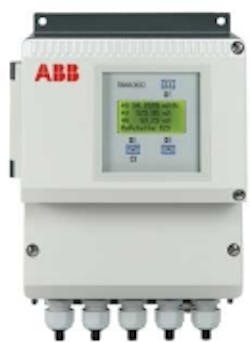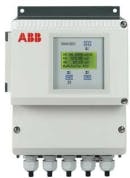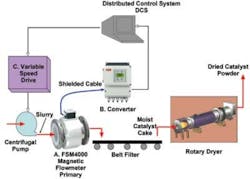Upgrading flowmeter stabilizes control of process slurry flow
by Robert Mapleston
• Replacing a faulty unit with an advanced design AC magnetic flowmeter eliminates erratic flow signals for dramatic improvement in catalyst slurry flow control for chemical processor.
An electromagnetic flowmeter on a three-inch line at a major industrial process catalyst maker in Savannah, GA, measuring catalyst slurry containing 30% solids continually produced erratic and erroneous flow readings, thwarting flow control efforts. The plant maintenance group, responsible for all plant instrumentation, tried various methods to correct magmeter performance without success. Meanwhile, operation under automatic control was impossible.
Situation
Figure 1 shows intermediate steps in the manufacture of catalyst, indicating the system designed to provide automatic control of slurry flow. A centrifugal pump with variable-speed drive controls catalyst slurry flow at a rate set by the Distributed Control System (DCS). Slurry goes to a belt filter that removes excess liquid and feeds moist catalyst cake into a gas-fired rotary dryer. Dried catalyst powder passes on downstream for further processing.
The original meter’s flow signals were erratic and unpredictable. They could call for excessive rates of slurry flow that caused the dryer to flame out and shut down the line. The control room operator could not depend on the measured flow readings, forcing reliance on manual control.
Solution
Plant maintenance decided to substitute the new FSM4000 magmeter from ABB Instrumentation for the original magmeter. Upon installation, the new meter performed exceptionally well, producing reliable, consistent flow signals that meant permitted operation via automatic control.
The FSM4000’s success in dealing with noisy applications originates with its use of 70 Hz AC excitation of the primary’s magnetic field combined with advanced digital signal processing. The measurement signal has an accuracy of +/-0.5% of rate, and offers a high speed of response.
Results
With dependable flow control readings, the process is now on automatic control, improving production and eliminating troublesome shutdowns.
The outstanding success with the FSM4000 on its first catalyst slurry application in the plant has led additional installations on similar slurry flow control systems. In one case, a higher temperature slurry required a double thickness of the PTFE liner in the magmeter primary, capable of withstanding fluid temperatures as high as 356°F (180°C). The standard PTFE and alternate liners of PTA and hard rubber are suitable for fluid temperatures from -40°F (-40°C) to +256°F (+130°C). These two FSM4000 installations were followed in rapid succession by four more on other plant slurry applications.
These and other environmental improvements at the facility allowed it to reduce total water releases 38% from 1988 to 2002. From 1998 to 2007, it also reduced chemicals released to the environment via surface water discharge by a similar amount, according to federal Toxic Release Inventory data. And, earlier this year, the company won a Green Excellence award from Frost & Sullivan.
About the Author: Robert Mapleston is North American marketing director at ABB Instrumentation in Warminster, PA. Contact: 800-829-6001, [email protected] or www.abb.us/instrumentation


